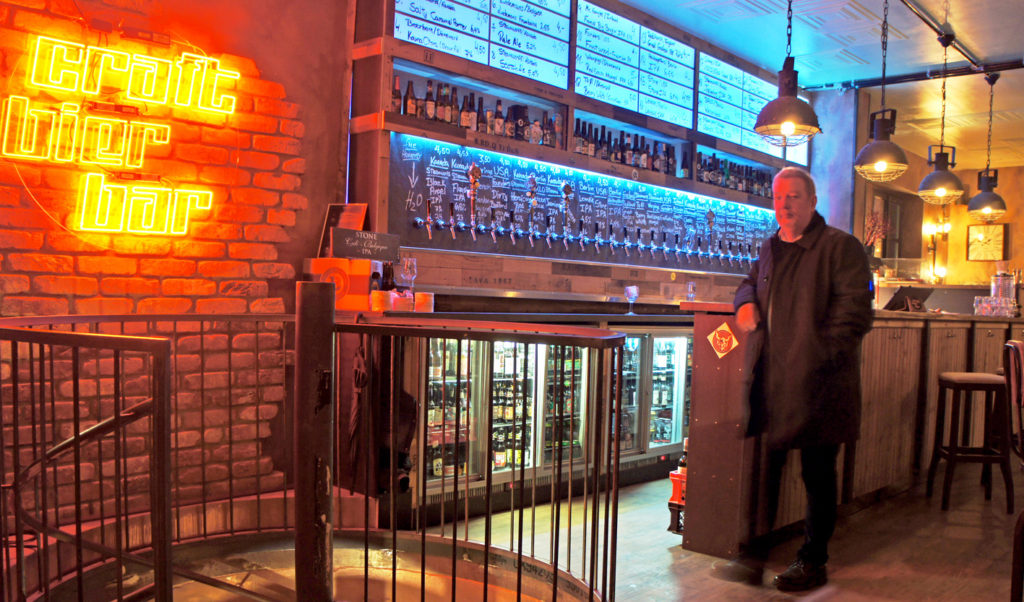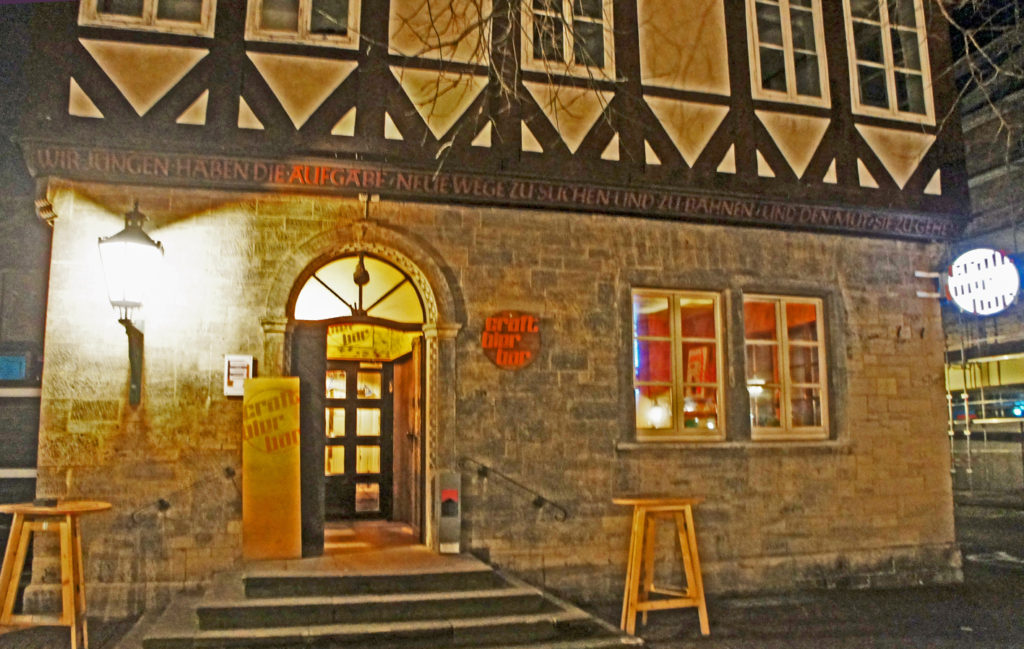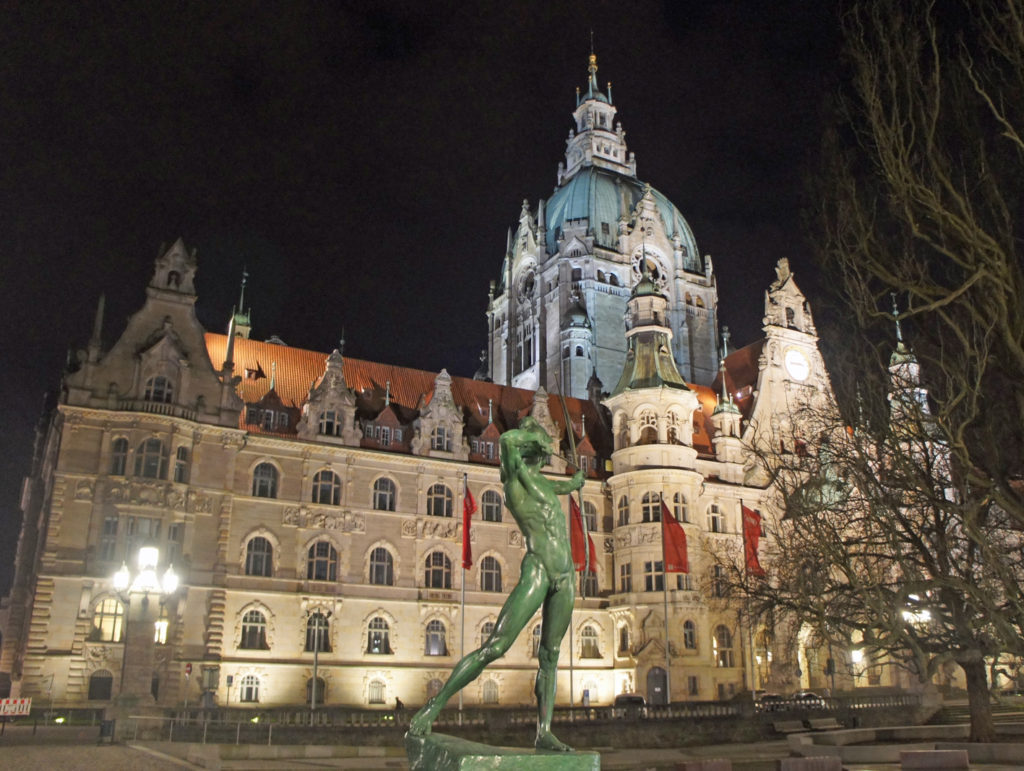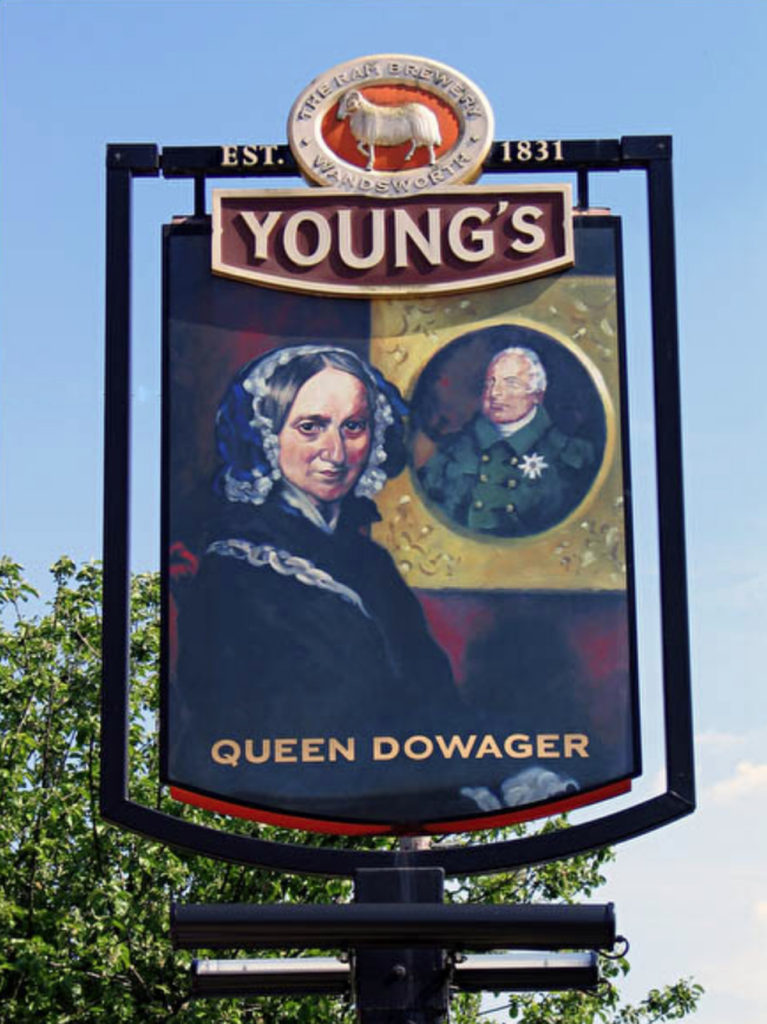
This is the Craft Bier Bar. It’s a craft beer bar. The Craft Bier Bar is the first ever craft beer bar in Hanover, apparently. It claims to have the largest selection of craft beers on draught of any bar in the whole of North Germany. The Craft Bier Bar ticks off all the craft beer bar signifiers: back wall with 24 draught beer taps sticking out; back-lit, numbered list high behind the bar, hand-written in marker pen, of draught craft beers from at least three continents; glass-doored refrigerators with brews in bottle and can even more exotic than those on tap (OK, Sam Smith’s Imperial Stout may not be exotic where YOU live, but it is in Niedersachsen); no mainstream brands; unplastered walls decorated with neon signs and ads featuring beers from Belgium to Oregon; Edison light bulbs; and prices at least twice as high per glass as anywhere else local.
Should business take you to Hanover, the Craft Bier Bar craft beer bar, in the Ballhofplatz in Hanover’s Old Town, is worth a call-in: you will certainly get an opportunity to try beers you won’t have had before. And some you have, of course: I’m not sure I have been in a craft beer bar anywhere that hasn’t been serving at least one brew from To Øl, and the Craft Bier Bar did not end this run. But be sure your wallet is well-stuffed before you step in. On my way to the Craft Bier Bar I popped in to a locals’ local to (a) get a decent wi-fi signal to recheck Google Maps (21st century problems) (b) see what the score was in the Germany-England match (0-0 at the time) and (c) wet my dry throat with a perfectly acceptable glass of Ratskeller pils from Gilde, Hanover’s AB InBev-owned big brewery. It cost me €1.90. Soon after in the CBB I was drinking a similar-sized glass of a fine, fruity American-style IPA from a small brewery in Berlin, Heidenpeters. It cost me €4.50: around £6.40 a pint.
Which left me musing: I was just about enjoying my first experience of a German craft beer bar, mostly because it WAS my first experience of a German craft beer bar, and worth savouring for that reason, but that apart, where would I rather be, back in the locals’ bar surrounded by a community of drinkers watching the footy, and paying nearly 60 per cent less for my beer, or trying to decide which of the other 23 draught beers available might be worth getting a bank loan for. Of which, and this is sad, just four were from German brewers.

In the final analysis, I decided the Craft Bier Bar was disappointing because, although being apparently perfectly well-run, with an excellent selection of beers, it was fundamentally a clone, a copycat experience, as ersatz as all the “Irish” pubs that bloomed briefly on British high streets in the 1990s, a repetition of an originally American style of drinking that you can now get around the globe, like McDonald’s, or, to be slightly fairer, Five Guys, and having as little real link with genuine beer culture, or my idea of genuine beer culture, as even Five Guys does with genuine gastronomy. I want a craft beer bar that doesn’t look as if it could be anywhere, in any city, I want it to have a beer selection that reflects the local scene more than it nods to the wider world. And I don’t want to feel its pricing policy takes the Michael.
And now, rant over, something else I pondered while in Germany: the largely unrecognised contribution Hanover has made to the iconography of the British pub. I don’t suppose many people from Hanover (or Hannover, as the locals prefer – emPHAsis on the middle syllAble) know there are still hundreds of British pubs – possibly a thousand or more – whose names have Hanoverian associations. It’s a reflection, of course, of the fact that Britain and Hanover shared rulers from 1714 to 1837. At least three pubs in England are actually called the Hanover, or Hanover Arms. The Hanoverian arms are the white horse on a red background that still appears on the flag of the German Land of Niedersachsen (“Lower Saxony” – I sometimes claim I live in Mittelsachsen), of which Hanover is the capital: and of the many pubs in Britain called the White Horse, a large number were first so named because their landlords wanted to show loyalty to the new royal family that arrived from North Germany after Anne, last of the Stuarts, died without managing to leave any surviving heirs, dozy tart.

How many pubs called simply the George are named after the run of four Hanoverian kings of the same name and how many after St George, mythical Turkish dragon-killer and patron saint of Catalonia, is probably impossible to disentangle, but there are plenty of pubs where a specifically numbered King George is commemorated. Strangely, George I never seems to have made it onto a signboard, but Georges II, III and IV did, the last more often as the Prince Regent. Pubs called the Brunswick are often named for the Prince Regent’s wife, Charlotte, daughter of the Duke of Brunswick, who was dumped by her husband within a year of their marriage. Others of George III’s sons to get themselves on signboards was Adolphus, Duke of Cambridge (the two pubs currently called the Duchess of Cambridge are named for the wife of the much more recent incarnation of that title).

The Prince Regent’s brother, William IV, was king when the Beerhouse Act was passed in 1830, which brought tens of thousands of new licensed premises into existence, and large numbers of new beerhouse keepers named their business after the new king. This means despite his comparatively brief reign, seven years, William IV is still the British king with the biggest number of pubs named after him, not counting the half dozen or more called the Duke of Clarence, his title before he was king, while his wife, Queen Adelaide, appears on around a dozen innsigns. (Until a few years ago she actually appeared on two pub signs in Teddington, Middlesex, the Adelaide, and the now closed Queen Dowager, her title after William died in 1837: she and William had lived next door in Bushy Park.) William IV’s niece, Queen Victoria, last of Britain’s Hanoverian monarchs, is the queen with the largest number of pubs named for her, of course. Her husband, Prince Albert, also has his face on pub signboards: but he’s a Saxe-Coburg, not a Hanover, and doesn’t count …

If you ever find yourself in Berlin – Steglitz, there is a beer bar called Foersters Feine Biere (Foerster’s Fine Beers) which specializes in only German specialities. Traditional and new craft beers. It is one of the best “new” beer bars in Germany and is equally parts cosy and refreshing. Service is excellent, staff is knowledgeable, and selection is fantastic.
On the International Craft Experience, I kind of agree with you as a travelling beer geek, but it always feels a bit pissy to moan about this sort of thing when the target audience is presumably not tourists looking for the authentic local culture but locals who’ve grown up with the authentic local culture and fancy a change. I’m happy to be able to eat and drink globally when I’m in the UK, I don’t see why people elsewhere shouldn’t do the same.
Secondly, and slightly more speculatively, there’s always the possibility that it’s the first step of an evolution towards something more distinctive anyway. The pattern where trends are initially imported, then imitated, then adapted isn’t uncommon.
Martin,
Just a footnote comment, but there’s a pub called the Prince Frederick in the Bromley/Sundridge Park area of South London named after George II’s son. I think that I’m right in saying that it is a unique name.
30 years ago, it was my local, and a cracking little place it was too!
Tbanks very much for that, one I didn’t know – he was George III’s dad, of course.
Martin,
“Named for” bothers me, probably unnecessarily and pointlessly, as an Americanism adopted by the young in place of the more customary “named after” (similar to “bored of” v. “bored by”). I notice you’re using both here. Do you have a rationale behind your usage, or are you just hedging your bets?
(Don’t mind me, the Balvenie brings out my inner pedant…)
Mike
The OED, which God preserve, allows “named after”, “named for”, which it finds as early as 1450, “named from”, and even “named to”, which it says is “Eng. regional (south-west)”, though it does say “named for” is “now chiefly N. Amer.” The New Fowler’s Modern English Usage, edited by R.W. Burchfield (Clarendon Press: Oxford, England. 1996) says that “named after” and “named for” were “fairly interchangeable until the 20th century, when ‘named for’ gained ascendancy in the US, and ‘named after’ became more popular in the UK.” The excellent “Separated by a common language” blog quotes the Cambridge International Corpus, which says BrE texts have 6.5 times as many afters as fors and AmE texts have 1.3 times as many fors as afters, suggesting British English does permit “named for” but prefers “named after”, while Yanks are less fussy. My own usage is entirely unthinking, and probably, in this instance, an example of unconscious inelegant variation. If you have been affected by this or any other issue in Zythophile, a helpline is available. Full refunds of subscriptions will be given to all readers unhappy in any way with the service they receive.
Heh. Thanks, I feel much better now…
Mike
Pedantry will always be available at Zythowarts to those who ask for it, Harry.
Don’t know too much about German beer, but here in Korea is seems to have fallen into the same trap as French wine. Either absolute shit that people only buy because it’s cheap and they associate Germany with beer or pretty good but nothing special and insanely overpriced.
Real shame you don’t see more German breweries digging through German beer history and bringing back old styles or variations. There used to be an insane variety of top fermenting beers, especially in northern Germany and I wish there were more interest in reviving some of it.
My friend has been brewing for both Heidenpeters and Vagabund in Berlin. She also works (busy lady) at Hopfen Und Malz http://hopfenmalz.de/ in Wedding (Berlin suburb) which is “supposed” to be the best bottle shop in the whole of Germany. I’ve had her send me two boxes of random beers from the shop and I have to say there was fantastic selection of both traditional German styles and some great craft stuff. The best example I’ve come across of the hop Mandarina Bavaria in a beer was from a Heidenpeters pale ale, which makes sense as you’d think the Germans would know how to use their own hop varieties!
I have had a fair few German ‘craft’ beers now and while on the whole they are well made, there is a tendancy towards cloning American styles. The same is happening in France (visit the marvellous Cave A Bulles http://www.caveabulles-paris.fr/en/ near the Centre Pompidou.) but with a lower quality threshold.
I feel it would be much more interesting for everyone if craft breweries started with their country’s traditional styles and played around with them rather than trying to ape American beers all the time – there are quite enough of those going round.
I very much enjoyed this article mainly for personal reasons: I used to work for a company with its headquarters in Hanover (TUI Travel — owner of Thomson/First Choice holidays) and would go on business to Hanover every couple of weeks. I used to stay over a lot (and late flights often led me to look for a beer even on exhausting day trips).
I know the Ballhofplatz area in the Old Town very well — it used to get transformed into a wonderful Finnish market at Christmas with salmon cooked over open fires and so on. I also used to visit a traditional bar opposite the Craft Bier Bar (I can’t remember what used to be in that building).
Having been almost a local there for nearly ten years I tend to endorse Dave S’s comments. Even in places like Hannover (oops, I’ve gone native) where superb beer is ubiquitous, it tends to be of a limited range of styles and there’s often local monopolies or duopolies in German cities – as in Hannover’s Gilde Ratskeller. So the craft beer bar isn’t really aimed at the visitor, it’s for the locals.
There’s been a brewpub close to the Old Town for a while now — the Ernst August Brauhaus which is worth a visit but didn’t over-impress me (seemed aimed at the corporate trade fair market). There was also the inevitable Irish pub in the main square.
My colleagues used to take me drinking to the Markthalle, which was the equivalent of the equivalent back-street boozer but the true German drinking experience is outdoors and Hannover has many green spaces where the locals drink enthusiastically en masse. I was there for the 2006 football World Cup — where locals and foreign supporters drank copious amounts of beer in the hot weather without a hint of trouble.
The best bar I found in Hannover was the Broyhanhaus literally round the corner from the Craft Bier House. It’s clearly an old building, something you don’t get an awful lot in German cities as they were thoroughly redecorated in the early 1940’s by that renowned town planner, Arthur Harris. Low ceilings, lots of wood, and a genuinely authentic German feel.
There’s also a brewpub a bit away from the old town, Meiers. A bit better than Ernst Augustus TBH, though both were pleasant without being memorable.
Getting back to the original topic, I think Martin is being a tad harsh. Along with the taps the Craft Beer House holds a very decent bottle selection packed with a variety of interesting beers, including some, but not all, from the local Brauerei Mashsee. I think they also have a small bar on the fringes of Hannover which only opens part of the week. The part of the week when I wasn’t in town, obviously.
Plus, during my visit, a beer on tap entitled “Berliner Scheisse”. And in terms of beer names, that takes some beating.
Wait, Five Guys is a thing outside the U.S.?! I guess I need to get out more.
On the topic of the “internationalization” (read: homogenization) of contemporary drinking culture, I’m right with you. I’ve been living in Vienna for the past 18 months, and have seen more than my fair share of anodyne “craft beer” establishments pop up around the city — none of which (unfortunately) would be out of place in Chicago or New York City. Some of them even charge (cough, gag) 5 euros for a goddam bottle of Sierra Nevada Pale Ale!
Someone above commented that these things might have something to do with a shift in drinking culture. Granted, that may well be the case. Not all the places that have opened their doors in the past two years here are trying to make a quick buck off of “craft.”
But still. When I can go to a place like Kangaruh (which, incidentally, isn’t that far away from Brickmakers, so the question of higher rents is a debatable point at best) and get a whole slew of awesome Belgian beers for not all that more than I’d pay for them in a Viennese bottle shop, what am I/we paying for? Maybe you’re on to something, Martyn, with the “signifying practices” of your run-of-the-mill craft beer establishment. Those back-lit signs don’t come cheap 😉
And then there are all those wonderful, wonderful Gasthäuser/Wirtshäuser at which so many craft beer drinkers turn their noses up. Their loss. Even if the beer isn’t spiked with some of my favourite ingredients (that’d be coffee, vanilla, and, this week, coconut), it’s pretty solid. And you might get to talk to some ur-alt and crusty Viennese folks.
I guess I should say “rant over” now, as is the custom these days.
I very much enjoyed the first part. Now I need to read the second part on the Hannoverian influence on British pub culture and nomenclature.
Cheers!
I pay more than 5 euros for SNPA RETLAIL here in Korea. Or I would if I ever bought it.
Just to note, €4.50 in English money is about £3.90. A pint in somewhere like Norway now, that may well be £6.40 if not more!
Thanks Martyn, just planned a business trip to Hanover and was thinking about this place, which was heavily advertised in a German craft beer magazine. Whilst living in Berlin, I may have a very ignorant attitude towards the rest of Germany offering any meaningful craft beer locations. But still – you have to visit Berlin if you want to learn what Germany has to offer in terms of craft beer. Some much has changed in the last 2 years – and I do not mean Stone Brewing, BrewDog and recently Mikkeller opening bars in Berlin.